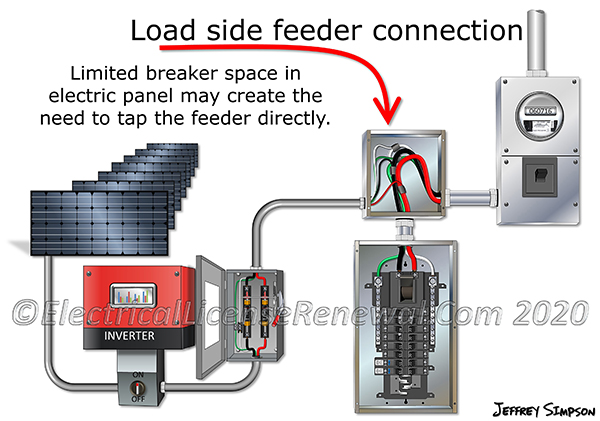705.12 Load-Side Source Connections.

Code Change Summary: Revisions were made to provide clarity on load-side connections for interconnected power production sources.
NEC Article 705 is all about connecting additional power production sources to the existing premises wiring system that operate in parallel with the primary source of electricity. This can include utility interactive PV systems, wind systems, fuel cells, energy storage systems, DC microgrids and the like.
Section 705.12 covers load side connections and allows interconnecting an alternate power source to the load side of the service disconnecting means of the other source at any distribution equipment on the premises.
The rules that follow in 705.12(B) provide for every type of possible interconnection scenario that is likely to be encountered. This includes source interconnections made to feeders, taps, and busbars. These rules can be difficult to follow without illustrations and a careful read.
Where distribution equipment or feeders are fed simultaneously (at the same time) by a primary source of electricity (such as the electric utility) and one or more other power sources and are capable of supplying multiple branch circuits or feeders, or both, the interconnecting equipment must comply with 705.12(A) through (E). These sections address interconnecting through a circuit breaker, fusible disconnect, feeder taps or busbars, and also provide the rules on marking the presence of all sources, line and load connections and fastening of backfed overcurrent devices.
Below is a preview of the NEC®. See the actual NEC® text at NFPA.ORG for the complete code section. Once there, click on their link to free access to the 2020 NEC® edition of NFPA 70.
2017 Code Language:
705.12(B) Load Side. The output of an interconnected electric power source shall be permitted to be connected to the load side of the service disconnecting means of the other source(s) at any distribution equipment on the premises. Where distribution equipment, including switchgear, switchboards, or panelboards, is fed simultaneously by a primary source(s) of electricity and one or more other power source(s), and where this distribution equipment is capable of supplying multiple branch circuits or feeders, or both, the interconnecting provisions for other power sources shall comply with 705.12(B)(1) through (B)(5).
(1) Dedicated Overcurrent and Disconnect. Each source interconnection of one or more power sources installed in one system shall be made at a dedicated circuit breaker or fusible disconnecting means.
2020 Code Language:
705.12 Load-Side Source Connections. The output of an interconnected electric power source shall be permitted to be connected to the load side of the service disconnecting means of the other source(s) at any distribution equipment on the premises. Where distribution equipment or feeders are fed simultaneously by a primary source of electricity and one or more other power source and are capable of supplying multiple branch circuits or feeders, or both, the interconnecting equipment shall comply with 705.12(A) through (E). Where a power control system (PCS) is installed in accordance with 705.13, the setting of the PCS controller shall be considered the power-source output circuit current in 705.12(A) through (E).
(A) Dedicated Overcurrent and Disconnect. Each source interconnection of one or more power sources installed in one system shall be made at a dedicated circuit breaker or fusible disconnecting means.